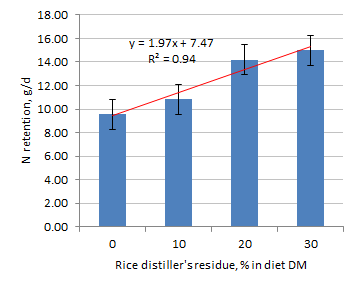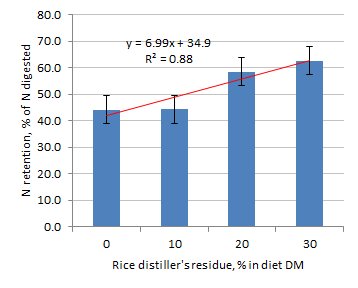Apparent digestibility of diets containing rice
distillers’ by-product, Taro (Colocacia esculenta) silage and rice bran in
growing pigs
Nouphone Manivanh, T R Preston* and Le Duc Ngoan**
Souphanouvong
University, Luang Prabang, Lao PDR
nouphone2007@yahoo.com
*Finca Ecológica, TOSOLY, UTA (Colombia)
AA #48, Socorro, Santander, Colombia
**Hue
University of Agriculture and Forestry, Hue City, Viet Nam
Abstract
Four crossbred
castrated male pigs, weighing on average 25 kg were allotted at random to 4
diets within a 4*4 Latin square design, to study effects of level of rice distillers’
residue (0, 10, 20, 30 % in DM) in combination with Taro silage (Colocasia
esculenta) and rice bran on digestibility
and N retention of growing pigs. The trial was conducted in the experimental
area of Souphanouvong University, in Luang prabang province, Laos, from
3rd April 2011 to 12th
May 2011.
Daily retention of N (Figure 1) and N retained as percent
of N digested (Figure 2) increased linearly with replacement of Taro silage by
rice distiller's residue and rice bran. It appears that the biological value of the
distiller’s residue is superior to that of Taro silage or that the distiller’s
residue provides some other nutrient – possibly a probiotic effect of the yeast.
Key words:
Biological value, feed intake, N retention, protein,
 |
 |
|
Figure 1.
N retention in pigs fed taro silage and rice bran, or mixtures of
the two, with increasing levels of rice distillers’ residue
(corrected for differences in N intake) |
Figure 2.
N retention as percent of N digested in pigs fed taro silage and
rice bran, or mixtures of the two, with increasing level of rice
distillers’ residue |

